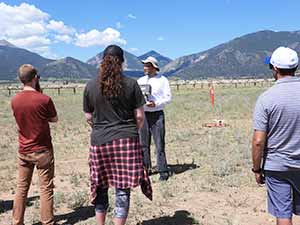
The use of unmanned aerial systems, or UAS, by industry may be in its infancy, but there are many businesses already using the technology. These include construction, entertainment, historic preservation, search and rescue, tourism and wildlife conservation.
To meet this growing demand, the University of Wyoming Board of Trustees, in June, approved the launch of geospatial information science and technology (GIST) programs. New programs, which began this fall, are offered in the areas of geographic information system (GIS), remote sensing and UAS, better known as drones.
An online graduate certificate program course, officially named “UAS Ground School and Operations,” took place earlier this fall. Christopher Leatherman, owner and chief remote pilot for Aerial Solutions of Wyoming, an unmanned aerial vehicle (UAV) company in Gillette, taught the course.
“2020 was the third field school I have taught for the University of Wyoming. This is the first virtual school we had due to the pandemic,” Leatherman says. “We worked with a flight simulator and controller from the company Little Arms Studios. I prefer to teach in person, but we must adjust with the times.”
During the ground school, students learned the basics of UAS safety and flight. This included the preflight processes to ensure the UAS is safe to fly before leaving the ground. Basic airspace rules were discussed so students understood where they can and cannot fly a drone.
“We start with simple flight maneuvers to help the students become comfortable with the aircraft. As their skills improve, the exercises become more complex,” Leatherman says. “These exercises include an obstacle course. At the end of the class, the students’ flight skills are tested.”
Leatherman’s own resolve was tested. Originally scheduled as a three-day, in-person course, plans for the class had to change after he was infected with COVID-19.
“I became sick for several days in early September. I went to my doctor and, after a few days, the COVID test came back positive,” Leatherman explains. “Thankfully, I did not need to go to the hospital, and I have recovered after a month. UW made the right call in moving the ground school to online. COVID is dangerous, and we must do what is necessary to prevent it from spreading.”
Leatherman says the biggest adjustment was rewriting the course so it could be taught online. He had been teaching ground school classes at the University of Denver for years. That course, too, had to be moved online this fall due to the pandemic.
“At first, the University of Denver planned on canceling the class,” he says. “However, the GIS director and I were able to save the class by finding the Little Arms Studios flight simulator and moving the course online.”
Ryan Apfel, a first-year graduate student in UW’s GIST master’s program, took Leatherman’s course because he was interested in learning how to operate a drone. During the class, he says he learned how to control the drone around different obstacles so that flying became more muscle memory than thought.
“I expect drones to become much more common in the environmental sector,” says Apfel, of Laramie. “Learning technical skills is usually a wise choice and may set me apart from other job candidates.”
Alex Greenfield, a UW senior from Wellington, Fla., majoring in geology, has worked in real estate and saw the drone course as an opportunity to expand his business services and establish a niche in the appraisal world. He recalled working for a client who had a number of agricultural investments. As a result, Greenfield was introduced to the practical advantages that unmanned drones could provide to help draw conclusions about the health of a site’s soil, crop vitality and many other aspects that could improve one’s understanding of real property.
“It also was an opportunity to familiarize myself with the controls while not destroying thousands of dollars in UW drones,” Greenfield jokes. “The simulation assignments ranged from basic takeoff and landing procedures to task-oriented obstacle courses in a variety of terrains.
“I initially crashed quite a bit in the simulators but, after a short time, I gained a good feeling for how to operate drones and what to expect in the field,” he continues. “Of course, I would welcome an opportunity for a ‘field make-up day’ to see just how capable I am with a real drone as a result of the simulator.”
“The geospatial information science and technology programs are giving students new options for earning credentials in the fast-growing and marketable field of geospatial science,” says Ken Driese, GIST program director for UW’s Wyoming Geographic Information Science Center (WyGISC). “Unmanned aerial systems, or drones, are cutting-edge tools that are changing how we collect data in many fields, and job growth for students trained in how to use UAS and interpret UAS data is strong.”
Graduate students can earn an online certificate in UAS that teaches them how to use drones in their research or their careers. Undergraduate students can earn a certificate in remote sensing, giving them a credential that is helpful for many jobs in and outside of Wyoming, Driese says.
Leatherman’s role at UW began in 2016 when he gave a presentation at UW’s UAS Symposium. He gave another presentation at the 2018 version of the symposium. During this time, Leatherman got to know Driese.
In spring 2019, Driese and the UW staff invited Leatherman to teach two weeklong UAS flight and mapping classes for the staff.
“For those classes, I taught the students the basics of safe drone flight and mapping,” Leatherman says. “These classes were one of many factors that helped persuade the UW Board of Trustees to approve the geospatial program.”
Leatherman is a Federal Aviation Administration-certified remote pilot and manned aircraft student pilot with extensive aeronautical knowledge. Additionally, he is a member of the Academy of Model Aeronautics, an organization of remote hobbyist pilots, and Drone U, a group of professional UAV pilots.

